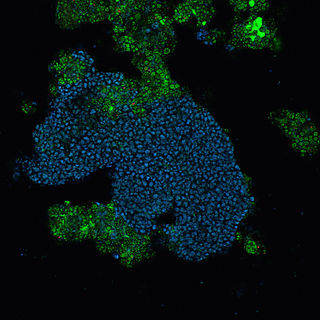Related Research Articles

Polyphosphate-accumulating organisms (PAOs) are a group of bacteria that, under certain conditions, facilitate the removal of large amounts of phosphorus from wastewater in a process, called enhanced biological phosphorus removal (EBPR). PAOs accomplish this removal of phosphate by accumulating it within their cells as polyphosphate. PAOs are by no means the only bacteria that can accumulate polyphosphate within their cells and in fact, the production of polyphosphate is a widespread ability among bacteria. However, the PAOs have many characteristics that other organisms that accumulate polyphosphate do not have, that make them amenable to use in wastewater treatment. Specifically, this is the ability to consume simple carbon compounds without the presence of an external electron acceptor by generating energy from internally stored polyphosphate and glycogen. Most other bacteria cannot consume under these conditions and therefore PAOs gain a selective advantage within the mixed microbial community present in the activated sludge. Therefore, wastewater treatment plants that operate for enhanced biological phosphorus removal have an anaerobic tank prior to the other tanks to give PAOs preferential access to the simple carbon compounds in the wastewater that is influent to the plant.
Thiothrix is a genus of filamentous sulfur-oxidizing bacteria, related to the genera Beggiatoa and Thioploca. They are usually Gram-negative and rod-shaped. They form ensheathed multicellular filaments that are attached at the base, and form gonidia at their free end. The apical gonidia have gliding motility. Rosettes of the filaments are not always formed but are typical. Sulfur is deposited in invaginations within the cell membrane.

Gemmatimonas aurantiaca is a Gram-negative, aerobic, polyphosphate-accumulating micro-organism. It is a Gram-negative, rod-shaped aerobe, with type strain T-27T. It replicates by budding.

"Candidatus Accumulibacter" is an unclassified group of Betaproteobacteria that currently contains only a single member, "Candidatus Accumulibacter phosphatis". "Ca. A. phosphatis" is a common bacterial community member of wastewater treatment plants performing enhanced biological phosphorus removal and is a polyphosphate-accumulating organism. There are currently no cultured representatives, however due to the importance of "Ca. A. phosphatis" in the biotechnology industry there has been much research into the physiology of these bacteria.

Candidatus Accumulibacter phosphatis (CAP) is an unclassified type of Betaproteobacteria that is a common bacterial community member of sewage treatment and wastewater treatment plants performing enhanced biological phosphorus removal (EBPR) and is a polyphosphate-accumulating organism. The role of CAP in EBPR was elucidated using culture-independent approaches such as 16S rRNA clone banks that showed the Betaproteobacteria dominated lab-scale EBPR reactors. Further work using clone banks and fluorescence in situ hybridization identified a group of bacteria, closely related to Rhodocyclus as the dominant member of lab-scale communities.
Malikia granosa is a Gram-negative, rod-shaped, motile bacterium with one to two polar flagella from the new genus Malikia in family Comamonadaceae. It was isolated from activated sludge of a municipal wastewater treatment plant. Colonies of M. granosa are creamy–white in color.
Microlunatus phosphovorus is the type species of the Microlunatus bacterial genus. It is Gram-positive and is notable for being a polyphosphate-accumulating bacterium. It is coccus-shaped, aerobic, chemoorganotrophic and its type strain is NM-1T.
Acinetobacter towneri is a Gram-negative, strictly aerobic bacterium from the genus Acinetobacter isolated from activated sludge in Bendigo in Australia.
Halomonas ventosae is a moderately halophilic, denitrifying, exopolysaccharide-producing bacterium. Its type strain is Al12T.
Shewanella decolorationis is a gram-negative, dye-decolorizing bacterium first isolated from activated sludge of a waste-water treatment plant. It is motile by means of a single polar flagellum. The type strain is S12T. Its genome has been sequenced.
Dietzia psychralcaliphila is a facultatively psychrophilic alkaliphile that grows on hydrocarbons. It is aerobic, non-motile and gram-positive. The type strain is ILA-1T.
Meganema perideroedes is a filamentous bacterium from the genus of Meganema which has been isolated from activated bulking sludge from industrial wastewater in Grindsted in Denmark.
Chryseobacterium indoltheticum is a bacterium from the genus of Chryseobacterium which has been isolated from marine mud.
Tetrasphaera is a bacterial genus from the family of Intrasporangiaceae.
Microlunatus is a Gram-positive, non-spore-forming, mesophilic, aerobic and non-motile bacterial genus from the family of Propionibacteriaceae.
Gordonia defluvii is a Gram-positive and non-motile bacterium from the genus of Gordonia which has been isolated from activated sludge foams in Australia.
Tetrasphaera australiensis is a Gram-positive bacterium species from the genus of Tetrasphaera which has been isolated from activated sludge from Glenelg in Australia.
Tetrasphaera japonica is a Gram-positive bacterium species from the genus of Tetrasphaera which has been isolated from activated sludge from Japan.
Tetrasphaera jenkinsii is a bacterium species from the genus of Tetrasphaera which has been isolated from activated sludge from Glenelg in Australia.
Tetrasphaera veronensis is a bacterium species from the genus of Tetrasphaera which has been isolated from activated sludge from Verona in Italy.
References
- ↑ Hanada, S. (2002). "Tetrasphaera elongata sp. nov., a polyphosphate-accumulating bacterium isolated from activated sludge". International Journal of Systematic and Evolutionary Microbiology. 52 (3): 883–887. doi:10.1099/ijs.0.01990-0. ISSN 1466-5026.